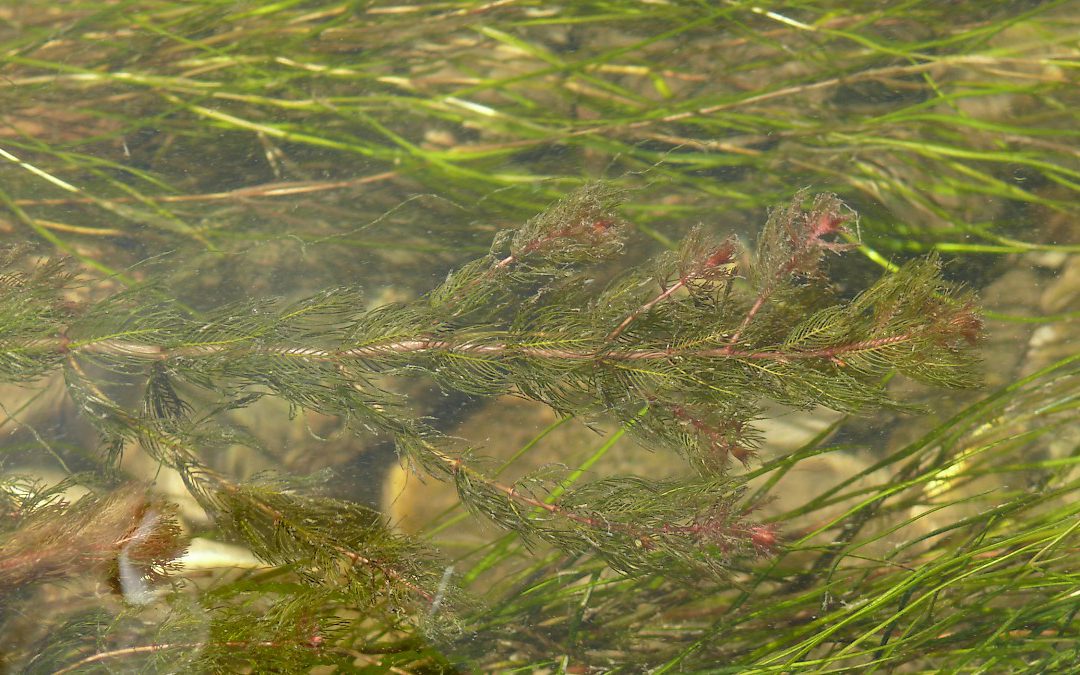
by Rick O'Connor | Jan 13, 2021
EDRR Invasive Species
Eurasian Milfoil (Myriophyllum spicatum)
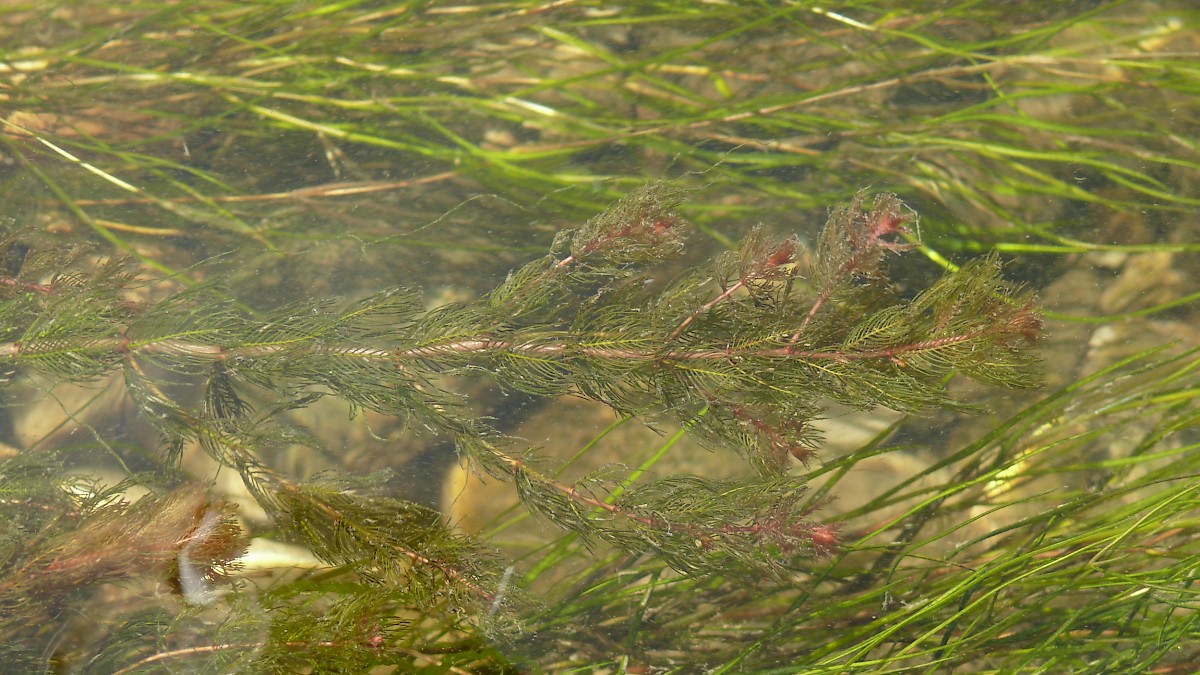
Eurasian milfoil.
Photo: University of Florida
Define Invasive Species: must have all of the following –
- Is non-native to the area, in our case northwest Florida
- Introduced by humans, whether intentional or accidental
- Causing either an environmental or economic problem, possibly both
Define EDRR Species: Early Detection Rapid Response. These are species that are either –
- Not currently in the area, in our case the Six Rivers CISMA, but a potential threat
- In the area but in small numbers and could be eradicated
Native Range:
Eurasian milfoil is native to Eurasia and north Africa.
Introduction:
There are two records of its possible introduction.
- Introduced accidentally in ship ballast entering the Chesapeake Bay in the late 1800s.
- Intentionally introduced in the Chesapeake Bay area in 1942.
EDDMapS currently list 20,532 records of this plant. Most are along the U.S. Canadian border.
Within our region there are 24 records. 11 in Bainbridge GA, one in Panama City, four in Apalachicola, and seven in south Alabama.
There are five records within Six Rivers CISMA, all in the Mobile delta.
Description:
Eurasian milfoil is a submerged, rooted, freshwater plant preferring slow moving waters.
It has long slender stems that are reddish-brown to whiteish-pink in color branching as it reaches the surface. The leaves are olive-green in color, less than 2” in length, and branching (feather-like). Leaf whorls along the stem are between 3-6 leaves but typically 4. Whorl nodes are 3/8” apart.
Flowers are reddish and attached to emersed spikes reaching above the water. The spike is about 8” long and the flowers are arranged in a whorl pattern around this. In Canada it flowers in late July and early August.
It can tolerate salinities up to 10 ppt and could be found in upper brackish systems.
The plant can grow in 20 feet of water but is most often found in waters less than 10 feet deep.
It can grow into large, dense mats, and can be the most common plant in the area.
Issues and Impacts:
Has been known to stop boat traffic.
Can completely cover the surface of the water reducing oxygen exchange and light for other submerged plants. Decaying mats can reduce dissolved oxygen even further.
Has been reported to negatively impact fish and birds.
Management:
Mechanical harvesters and chopping machines have been used but fragments can re-sprout.
Underwater vacuuming has been tried in Canada.
In bodies of water where this can be done, water draw down has been effective.
Biological controls using fish and insects have had some success.
Aquatic herbicides have been used to help control but rarely eradicate the plant completely.
EDUCATE BOATERS TO CHECK THEIR BOATS AND TRAILERS WHEN ENTERING AND LEAVING WATER BODIES WHERE EURASIAN MILFOIL MIGHT EXIST.
DO NOT DISCHARGE UNWANTED AQUARIUM PLANTS INTO LOCAL WATERWAYS.
It is currently not listed as a federal noxious weed and continues to be sold as a plant for aquariums.
For more information on this EDRR species, contact your local extension office.
References
Eurasian milfoil, University of Florida IFAS Center for Aquatic and Invasive Plants
https://plants-archive.ifas.ufl.edu/plant-directory/myriophyllum-spicatum/
Early Detection and Distribution Mapping System (EDDMapS)
https://www.eddmaps.org/
Six Rivers CISMA
https://www.floridainvasives.org/sixrivers/
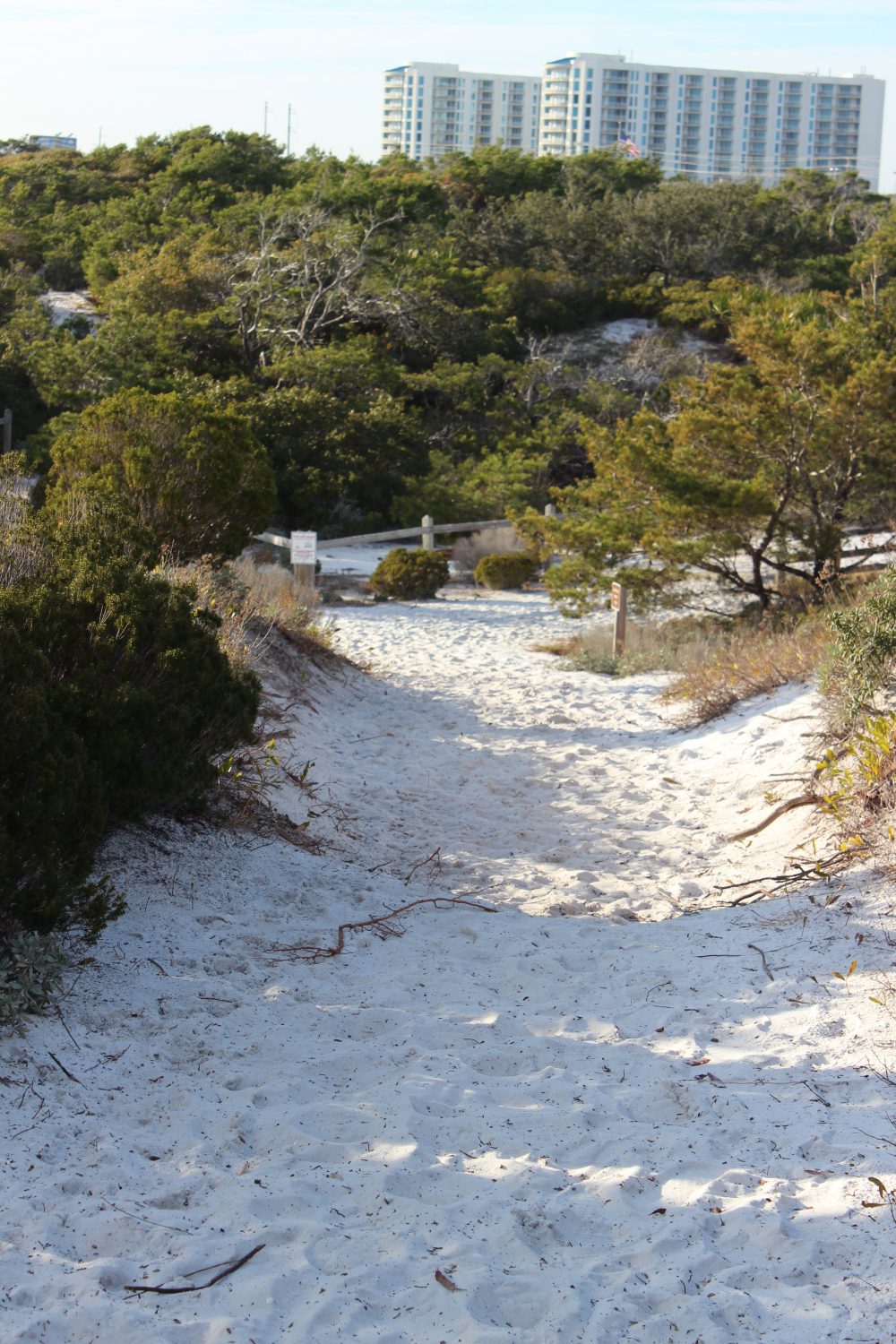
by Rick O'Connor | Jan 8, 2021
It’s winter…
The sky is clear, the humidity is low, the bugs are gone, and the highs are in the 60s – most days. These are perfect days to get outside and enjoy. But the water is cold and you do not want to get wet – most days. And with COVID hanging around we do not want to go where there are crowds. Where can I go to enjoy this great weather, the outdoors, but stay safe?

As the summer heat fades, the weather is great for hiking! Photo credit: Abbie Seales
Hiking…
My wife and I have already made several hikes this winter and have enjoyed each one. Each panhandle county has several hiking trails you could visit. In our county there are city, county, state, and federal trails to choose from. The Florida Trail begins in Escambia County, at Ft. Pickens on Santa Rosa Island, and dissects each county in the panhandle on its way to the Everglades. You could find the section running through yours and hike that for a day. Community parks, our local university, state and national parks, and the water management district, all have trails.
Some are a short loops and easy. Others can be 20 plus miles, but you do not have to hike it all. Go for as long as you like and then return to the car. Some are handicapped access, some have paved sections, or boardwalks. Some go along waterways and the water is so clear in the winter that you can see to the bottom. Many meander through both open areas and areas with a closed tree canopies.
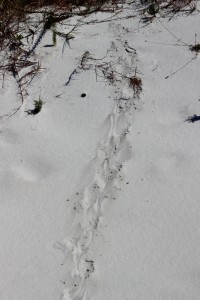
The tracks of the very common armadillo.
Photo: Molly O’Connor
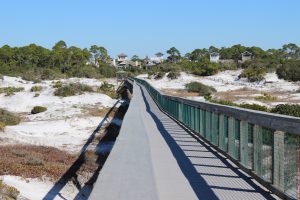
The boardwalk of Deer Lake State Park off of Highway 30-A. you can see the tracks of several types of mammals who pass under at night.
Being winter, the wildlife viewing may be less. The “warm bloods” are moving – birds and mammals. Actually, the birds are everywhere, it is a great time to go birding if you like that. Mammals are still more active at dawn dusk, but their tracks are everywhere. We have seen raccoon, coyote, and deer on many of our hikes. But the insects are down as well. We have not had a yellow fly or mosquito gives us a problem yet. Some fear snakes, we actually like the see them, but we have not. Many will come out of their dens when the days warm and the sun is out to bask for a bit before retreating back into their lair. You might feel more comfortable hiking knowing the chance of an encounter one this time of year is much less.
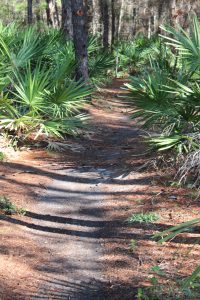
One of the many Florida State Forest trails in South Walton.
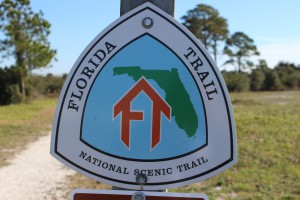
The Florida Trail extends (in sections) over 1,300 miles from Ft. Pickens to the Florida Everglades. It begins at this point.
But the views are great and the photography excellent. Some mornings we have had fog issues, but it quickly lifts, and the bay is often slick as glass with pelicans, loons, and cormorants paddling around. These have made for some great photos.
Things to consider for your hike.
Good shoes. Many of the trails we have hiked have had wet and muddy sections.
Temperature. There can be big swings when going from open sunny areas to under the tree canopies. Wear clothes in layers and have a backpack that can hold what you want to take off. Some like to wear the fleece vests so they do not have to put on/remove as they hike.
Water. I bring at least 32 ounces. It is not hot, but water is still needed.
Snacks. Always a plus. I always miss them when I do not have them.
Camera. Again, the scenery and the birds are really good right now.
The best thing is that you are getting outside, getting exercise, and getting away from the crazy world that is going on right now. Take a “mind break” and take a hike.
Here are some hikes suggested by hiking guides.
Gulf Islands National Seashore / Ft. Pickens – Florida Trail (Ft. Pickens section) – 2 miles – Pensacola Beach
Blackwater State Forest – Jackson Red Ground Trail – 21 miles – near Munson FL
Falling Waters State Park – Falls, Sinkhole, and Wiregrass Trail – ~ 1 mile – near Chipley on I-10
Grayton Beach State Park – Dune Forest Trail – < 1 mile – 30-A in Walton County
T.H. Stone Memorial St. Joseph Peninsula State Park – Beach Walk and Wilderness Preserve Trail – ~ 9 miles – near Port St. Joe FL
Apalachicola Bluffs and Ravine Preserve – Garden of Eden Trail – 4 mile loop – Hwy 12 near Bristol FL
Torreya State Park – Torreya River Bluff Loop Trail – 7 mile loop – Hwy 271 near Bristol
Leon Sinks Geological Area – Sinkhole and Gumswamp Trail – 3 mile loop – US 319 near Tallahassee
Edward Ball Wakulla Springs State Park – Sally Ward Springs and Hammock Trails – 2.5 miles out and back – Hwy 20 near Wakulla FL
St. Marks National Wildlife Refuge – Stoney Bayou Trail – ~ 6 miles – CR 59 near Gulf of Mexico
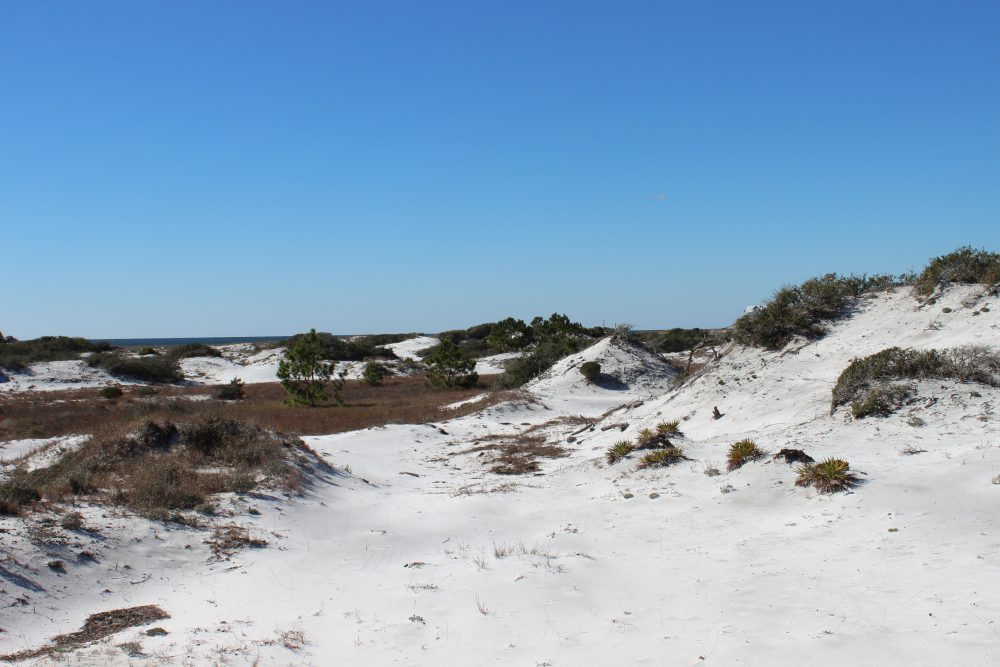
by Rick O'Connor | Dec 3, 2020
Along the northern Gulf coast is a string of long-thin sand bar islands we call barrier islands. They are called this because they serve as a barrier to the mainland from open water storms. These long sandy islands are very dynamic and constantly shift and move with the tides, currents, and waves. They can shift as far as 300 feet after a strong hurricane.

The white quartz sand beaches of the barrier island in the northern Gulf of Mexico.
Photo: Molly O’Connor
Life on these islands can be very tough. In addition to the constantly moving sand, there is salt spray in the wind, intense sunlight much of the year, high winds at times, and little rainfall to provide freshwater. Even though our area can receive as much as 60 inches of rain a year, much of this falls in the northern end of the counties, and not on the beaches. That said, there are freshwater ponds on some the islands and even larger dune lakes in Walton County – there life is not as hard.
As you cross a barrier island from the Gulf to the bay, you will cross distinct environmental zones. These zones are defined by the abiotic factors wind and salt spray and are named by their dominant plant forms having distinct animal life associated with them.
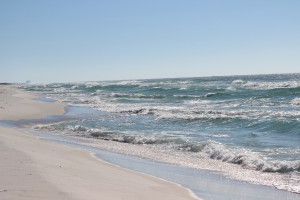
The beach zone seems life-less but it is not. Look beneath the sand.
Photo: Molly O’Connor
The beach is barren. This is the section of sand that extends from the water line of the Gulf to the first line of dunes. Few, if any plants can grow here. The high wave energy will not allow plants to grow along the shoreline, nor in the water itself. The wind and salt spray are high and the sand ever changing. All of the animal life here lives beneath the sand. They emerge when the wind and waves have slowed and scavenge on what they can find for food. Their primary production comes from the decomposition of the strands of seagrass and seaweed that line the shore – what we call wrack. Many will filter phytoplankton from the water as the waves wash in and seabirds are constant predators. When conditions get a little too much, they migrate a little offshore in deeper water to wait it out. But here fish and larger invertebrates become predators – so, they may not stay long.
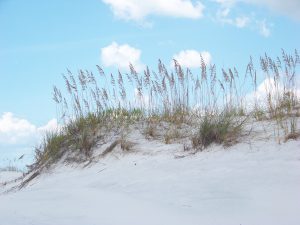
The primary dune is dominated by salt tolerant grasses like this sea oat.
Inland of the beach is the first dune line – the primary dune. This dune field is dominated by grasses because woody plants cannot tolerate the high wind. Most of these herbaceous plants have fibrous root systems that trap blowing sand and form dunes. The dominant grasses found here would include panic grass, beach elder, and the sea oat. The seeds of these plants provide food for creatures like the beach mice and some birds. Ghost crab burrows are often found here seeking shelter from the high energy environment of the beach. And, as you would expect, predators visit. Snakes, coyotes, and fox seeking the small mice.
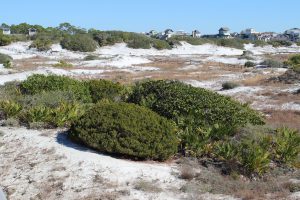
Small round shrubs and brown grasses within the swales are characteristic of the secondary dune field.
Photo: Rick O’Connor
This primary dune line blocks some of the wind and salt spray from the Gulf and allows small woody shrubs to grow. These shrubs will form a secondary dune system, which may grow slightly higher than the primary dunes. Shrubs like seaside rosemary, goldenrod, and false rosemary can be found here and give the dunes color when they are in bloom. The grasses found in the primary dune can also be found here. Beach mice and ghost crabs can work their way to this environment but because the wind is blocked by the primary dune other animals can be found here including: armadillos, opossum, a variety of snakes, and maybe even a gopher tortoise. Within the secondary dune field there are low areas that, at times, fill with rainwater. These are called swales and have their own unique wildlife. Grasses like broomsedge, needlerush, and bull rush can be found here. Along the edge you may find carnivorous plants such as the sundew. Freshwater attracts all wildlife, but the tenants could include a variety of amphibians, reptiles, and even some hardy species of fish.
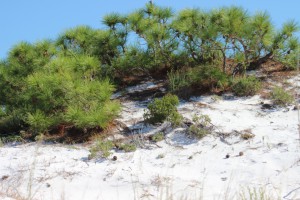
The top of a pine tree within a tertiary dune.
Photo: Molly O’Connor
On the back side of the island are some of the largest dunes. These are held in place by salt tolerant trees such as live oak, pine, and even magnolia. However, these trees look different than the ones that grow in our yards. They are the same species, but their growth seems stunted and often they look like the wind has blown their growth northward. This is known as wind sculpting and all of it is caused by the salt spray coming from the Gulf. These trees form a maritime forest where a variety of wildlife species do well. Deer, armadillo, opossum, skunks, coyote, fox, raccoon, hawks, owls, eagles, all sorts of snakes and woodland birds can be found here. In these xeric conditions, it is not uncommon to find a lot of cactus. Most of these creatures are hiding during the day, but at sunset they begin to move.
During these colder winter months, we encourage you to explore these beach habitats.
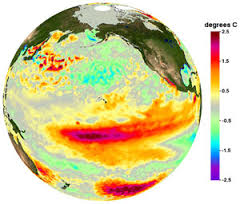
by Rick O'Connor | Nov 19, 2020
I think we can all agree it has been one crazy hurricane season. We have gone through the entire alphabet, and much of the Greek alphabet, naming storms – a record 30. Here in Pensacola we had Sally, but we had to prepare for many others that were wobbling around out there. It seemed this year the computer models were struggling predicting landfall locations. The “spaghetti” paths of the recent Eta were all over the Gulf. So, what is going on? It probably has to do with a warmer Gulf but there has to be more to it than that. Some have mentioned that it has been a La Nina year, and that the Gulf is more active during such years. Fair enough… what is the La Nina?
It is the opposite of the El Nino – a term more people have heard of. Okay… what is the El Nino?
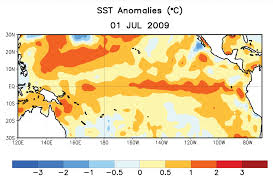
The red indicates warm water temperatures. Notice the warm temps in the eastern Pacific – not normal.
Graphic: NOAA
The El Nino is a warming trend observed in the eastern Pacific Ocean every 2-7 years around Christmas time. El Nino… “the child”. There are records of this event going back over a century. It was first noticed by Peruvian fishermen, who fish some of the most productive waters on the planet. These productive waters are fueled by the cold Humboldt Current and an upwelling bringing nutrient rich cold waters from the seafloor. When the El Nino occurs the Humboldt Current warms and “caps” the upwelling from reaching the surface where the food chain can benefit. The fish move away, and the fishermen notice it. When people began to colonize southern California, and began fishing for tuna and sardines, they noticed the same thing. The El Nino moved north of the equator just as it moves south of it.
To better understand this, we will need to know a little about the ocean currents.
The world rotates on its axis every 24 hours – there, we are off to a good start.
The sun’s rays hit the earth more directly in the equatorial part of the planet, making it warmer there.
The cold polar water is more dense and sinks. The warmer equatorial waters move across the surface of the ocean to fill the void left by the sinking polar water. But it does not move in a straight line to that point. The world is turning remember, and this cause the moving water to bend in a curved pattern. The equatorial water moves west by northwest, warming more as it moves. This is the equatorial current. When it reaches Indonesia it is a balmy 80F+ (or so). This is the land of palm trees and coral reefs – “Bali-Hai”.
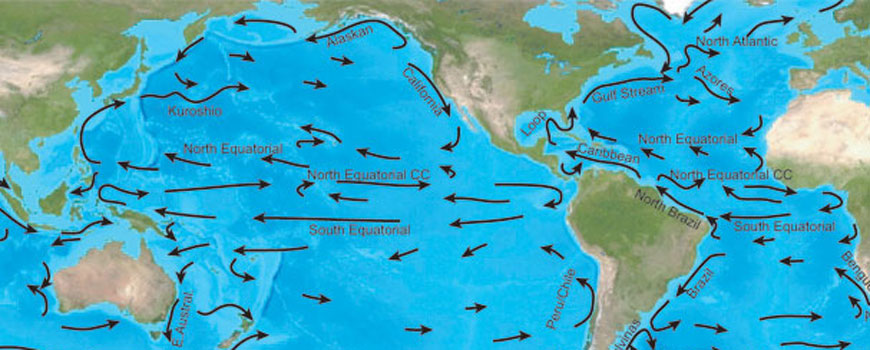
The equatorial currents of the Pacific.
Image: NOAA
The water now moves north towards Japan and Korea before heading towards Alaska. Here it is called the Kuroshio Current and here it slowly begins to lose its warmth. As it slides beneath Alaska heading for Canada it is called the North Pacific Current, and then becomes the California Current as it passes the western United States heading back towards the equator. Here the water is much cooler (60-70F). There are no coral reefs, but you do find palm trees in southern California. This coast is also bathed with an upwelling and supports a rich fishery.
The southern Pacific is the same – but the current names are different. The equatorial current heads west reaching Indonesia and heads south to Australia where they call it the East Australian Current (the EAC of Finding Nemo fame). This is the home of the Great Barrier Reef. The currents circle near Antarctica, become colder, and head north along South America as the Humboldt Current (also known as the Peru Current).
Now imagine this…
Imagine the warm equatorial water near Indonesia begins to slide back towards California and Central America. Imagine this warm water layer then heads north and south to the coasts of California and Peru. This warm water caps the upwelling and the fish leave – near Christmas time – the El Nino. Bad times for the fishing fleet.

Commercial fishing in the California Current.
Photo: NOAA
The atmosphere responds to these ocean temperature shifts. Normally, the cooler waters reaching the equator from California and Peru move westward forming the equatorial current. This cool water helps form east winds that move across westward as well. Known as the Trade Winds, sailors have used them for centuries to reach “good trading locations”. They are steady and dependable… unless it is an El Nino year. During El Nino the warmer ocean slows the strength of these winds. They actually move eastward across Central America and impact the Gulf of Mexico. During El Nino years these eastward moving Pacific winds push hurricanes out of the Gulf into the Atlantic. These are the hurricane seasons when Bermuda is hit frequently.
La Nina is the opposite. The Pacific waters moving into the equatorial area from California and Peru are colder than normal. These colder waters move faster and farther across the equatorial waters of the Pacific increasing the Trade Winds moving west… not east. With these Trade Winds moving in the direction they should, even stronger than normal, hurricanes are “sucked” into the Gulf of Mexico. La Nina seasons are very busy hurricane seasons for us. And you guessed it, it is a La Nina year. La Nina usually follows the El Nino and we can sometimes experience them for two seasons, but 12 months is typical.
The thing is La Nina’s have been occurring for centuries. We have certainly had hurricane seasons that were busier than normal but not to the extent we saw this year. You have to look at climate change in general, and other atmospheric conditions that could influence this. I am sure the meteorologists and climatologists are as interested in what happened (is happening) this year as we are.
Hopefully we will not see another season like this for some time.
Happy Thanksgiving.

by Rick O'Connor | Nov 13, 2020
This bio of our friend Shep Eubanks was prepared by Dr. Pete Vergot; Northwest District Extension Director.
Mr. Shepard “Shep” Eubanks, County Extension Director and Extension Agent IV

Shep Eubanks
Gadsden County Extension Director
In 1982 Shepard “Shep” Eubanks began working for the University of Florida as a student in Animal Science where he completed his bachelor’s degree in Animal Science in 1985 and then completed a master’s degree in Animal Science at the University of Florida in 1988. After graduation he started his first position with the University of Florida IFAS Extension as the Livestock Extension Agent I for Columbia County. During this time, Shep cultivated his knowledge and experience of working with farmers and ranchers and introduced his knowledge and love for natural resources and the outdoors. In 1993 Shep was promoted to Extension Agent II with Permanent Status and began his new position in Holmes County Florida as the County Extension Director and Agricultural and Natural Resources Agent where he continued to develop his skills of consulting with farmers, ranchers, and homeowners and a new audience of local county officials. As the County Extension Director, Shep was instrumental in moving from a small three-room office in the Holmes County courthouse to a recently renovated Agricultural Center and Extension office in Bonifay, Florida. Shep hired and worked with a staff of Extension Agents and support staff. In 1997, Shep was promoted to Extension Agent III and in 2003 he was promoted to Extension’s highest rank of Extension Agent IV.
Having an opportunity in 2015 Shep moved “home” to Gadsden County, with his
wonderful wife Genea and their two grown sons, John and Justin, to become the University of Florida IFAS County Extension Director and Agriculture and Natural Resources Extension Agent for Gadsden County. Shep worked with farmers, ranchers, and large landowners and homeowners, assisting them in all areas of agriculture and natural resources providing educational programming leadership and individual consultations to all Gadsden County residents. As the County Extension Director, Shep provided leadership for other Extension Agents and support staff. Shep worked with the former County Extension Director Dr. Henry Grant, along with the Gadsden County Commissioners and leadership, to continue to secure funding and build a new Gadsden County Agricultural Center and convert the older building into the Inman Livestock Pavilion.
Shepard “Shep” Eubanks will always be remembered as a kind and thoughtful person, willing to help and assist everyone that he met. Shep was a mentor to many younger Extension Agents and a friend to all Extension Agents across the Florida Panhandle and the State of Florida.





















